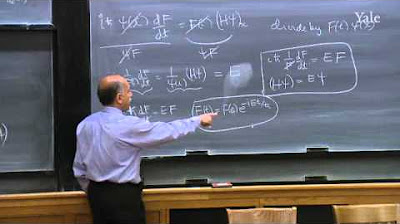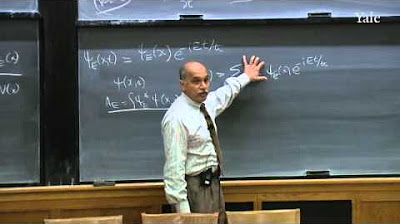Quantum Physics: Part 2. Superposition. Particle in a box 🌚 Lecture for Sleep & Study
TLDRThis lecture delves into the heart of quantum mechanics, exploring the Schrodinger equation and its solutions. It explains the concept of stationary states, highlighting their properties such as orthogonality and completeness, and how they form a basis for describing quantum systems. The lecture also introduces the use of Fourier analysis to express initial conditions as a sum of stationary states, illustrating the time evolution of wave functions. Through simulations and mathematical analysis, the video provides a visual and conceptual understanding of quantum behavior, emphasizing the discrete nature of energy levels and the dynamic interplay between time and probability in quantum systems.
Takeaways
- 📚 The Schrodinger equation is a fundamental equation in quantum mechanics, describing the behavior of quantum systems over time.
- 🔄 Separation of variables is a key technique used to solve the Schrodinger equation, breaking it down into simpler ordinary and partial differential equations.
- 🌐 The solutions to the Schrodinger equation can be stationary states, which are time-independent and have specific energies and wave functions.
- 📈 The time evolution of a quantum system is determined by the time-dependent part of the Schrodinger equation, which can be expressed as a complex exponential function.
- 🌊 Partial differential equations (PDEs) like the Schrodinger equation have multiple independent variables, making them more complex than ordinary differential equations (ODEs).
- 🔢 The Hamiltonian operator in the Schrodinger equation is related to the total energy of a system, including kinetic and potential energy components.
- 📊 Stationary states are solutions to the time-independent Schrodinger equation and have a precise energy associated with them, with no uncertainty in energy.
- 🔄 Superpositions of stationary states can result in complex and non-trivial time dynamics, which are fundamental to understanding quantum behavior.
- 🌟 The linearity of the Schrodinger equation allows for the construction of general solutions by superimposing any number of stationary state solutions.
- 📈 The expectation values of physical operators, such as position or momentum, evolve over time according to the Schrodinger equation's time-dependent part.
Q & A
What is the main focus of the lecture?
-The main focus of the lecture is solving the Schrödinger equation, which is a fundamental equation in quantum mechanics.
What is the separation of variables technique?
-The separation of variables is a solution technique used for partial differential equations, including the Schrödinger equation. It involves expressing the solution as a product of functions, each depending on a single variable.
What is the difference between ordinary and partial differential equations?
-Ordinary differential equations involve functions of a single variable and their derivatives, while partial differential equations involve functions of multiple variables and their partial derivatives.
How does the potential function influence the solutions of the Schrödinger equation?
-The potential function encodes the environment into the Schrödinger equation. It affects the spatial part of the wave function and determines the energy levels and behavior of the quantum system.
What is the significance of stationary states in quantum mechanics?
-Stationary states are solutions to the time-independent Schrödinger equation. They have constant probability densities and expectation values, and their energy is exactly determined. They are important because they can be used to construct more complex wave functions and understand the behavior of quantum systems.
How does the time evolution of a quantum system described by a wave function occur?
-The time evolution of a quantum system is described by the time-dependent part of the wave function, which is a complex exponential function of time. This part of the wave function evolves in a circular motion in the complex plane, while the spatial part remains unchanged.
What is the relationship between the Hamiltonian operator and the energy of a system in quantum mechanics?
-The Hamiltonian operator is related to the total energy of a system. In the context of the time-independent Schrödinger equation, the Hamiltonian operator acting on the spatial part of the wave function is equal to the energy of the state times the spatial part of the wave function.
What is the significance of the linearity of the Schrödinger equation?
-The linearity of the Schrödinger equation allows for the superposition of solutions. This means that if two functions are solutions to the Schrödinger equation, their linear combination is also a solution. This property is crucial for constructing general solutions to the equation.
How does the expectation value of an operator change with time for a stationary state?
-For a stationary state, the expectation value of any operator, including the Hamiltonian operator, does not change with time. This is because the time-dependent part of the wave function for a stationary state is a complex exponential, which when used in the calculation of expectation values, results in the time dependence canceling out.
What is the role of boundary conditions in solving the Schrödinger equation?
-Boundary conditions are crucial in determining the specific form of the solution to the Schrödinger equation. They are used to determine the constants in the general solution and ensure that the wave function is physically meaningful, i.e., it satisfies the given conditions of the problem.
How does the energy uncertainty in a stationary state compare to the energy time uncertainty relation?
-In a stationary state, the energy uncertainty is exactly zero because the state has a precise, exact energy. According to the energy time uncertainty relation, if the energy uncertainty is zero, the time uncertainty must be infinite. This means that a stationary state exists for all time, which is a theoretical concept and not physically realistic.
Outlines
📚 Introduction to Quantum Mechanics and the Schrodinger Equation
The video begins with an introduction to quantum mechanics, focusing on the Schrodinger equation. It explains the importance of this equation in understanding quantum systems and sets the stage for discussing the solution techniques, particularly the separation of variables method. The video also touches on the difference between ordinary and partial differential equations, emphasizing the complexity of the latter in relation to the Schrodinger equation.
🔄 Separation of Variables and Partial Differential Equations
This section delves into the solution technique of separation of variables, which is key to solving the Schrodinger equation. It explains how this method applies to partial differential equations, using the example of the electric field and Gauss's law. The video illustrates how the separation of variables simplifies the process, transforming the equation into a more manageable form by treating the electric field as the gradient of a potential.
🌀 The Wave Equation and its Implications
The video discusses the wave equation, which is derived from the acceleration of a string under tension. It explains how the curvature of the string relates to the force applied, leading to the mathematical expression of the wave equation. The video also covers the concept of separation of variables in the context of the wave equation, showing how it simplifies the equation into two ordinary differential equations.
📈 Solving the Time-Independent Schrodinger Equation
This part of the video focuses on solving the time-independent Schrodinger equation. It explains how the Hamiltonian operator is related to the total energy of the system and how the potential energy operator encodes the environment. The video also clarifies the notation used in quantum mechanics and emphasizes the importance of understanding the time-independent part of the wave function.
🌟 Stationary States and their Properties
The video discusses the concept of stationary states, which are solutions to the time-independent Schrodinger equation. It explains that these states have constant probability densities and expectation values, meaning they do not change over time. The video also touches on the energy associated with these states, stating that they have a precise, exact energy with no uncertainty.
🔄 Time Evolution in Quantum Mechanics
This section explains the time evolution aspect of quantum mechanics. It describes how the time-dependent part of the wave function evolves in a simple, rotational manner in the complex plane. The video emphasizes that while the time evolution is trivial, the spatial part of the wave function is more complex and is where the physics of the scenario enters.
📊 Expectation Values and Energy Uncertainty in Quantum States
The video explores the calculation of expectation values for operators in quantum mechanics, highlighting that these values are constant for stationary states. It also discusses the concept of energy uncertainty in quantum states, explaining that stationary states have no energy uncertainty due to the infinite duration of their existence, which is a result of the energy-time uncertainty relation.
🔄 Superpositions of Stationary States
This part of the video discusses the superposition of stationary states, which is fundamental to the linearity of the Schrodinger equation. It explains that any solution to the Schrodinger equation can be expressed as a superposition of stationary states, and that this superposition results in non-trivial time dynamics. The video also touches on the concept of Fourier analysis in relation to the superposition of stationary states.
🌐 Potential Functions in Quantum Mechanics
The video concludes with a discussion on potential functions in quantum mechanics. It explains how the potential function influences the physics of quantum systems and how it appears in the Schrodinger equation. The video also provides examples of different potential functions, such as the infinite square well and the harmonic oscillator, and how these potentials affect the solutions of the Schrodinger equation.
Mindmap
Keywords
💡Schrodinger equation
💡Stationary states
💡Wave function
💡Potential energy
💡Quantum mechanics
💡Energy levels
💡Separation of variables
💡Normalization
💡Superposition
💡Fourier's trick
Highlights
The Schrodinger equation is a fundamental equation in quantum mechanics that describes the behavior of quantum systems.
Solving the Schrodinger equation involves techniques such as separation of variables, which is applied repeatedly to the equation.
The Schrodinger equation is a partial differential equation, making it more complex than ordinary differential equations.
Stationary states are solutions to the time-independent Schrodinger equation and have no time dependence.
The energy of a stationary state is given by the separation constant e, and there is no uncertainty in its energy.
Superpositions of stationary states can result in non-trivial time dependence and are fundamental to understanding quantum dynamics.
The linearity of the Schrodinger equation allows for the construction of complex solutions from stationary states through superposition.
Potential functions in the Schrodinger equation represent the environment and influence the solutions of the equation.
The infinite square well potential, also known as the particle in a box model, is a simple potential function used to understand quantum confinement.
Solutions to the time-independent Schrodinger equation for the infinite square well potential are sine functions, which exhibit discrete energy levels.
The orthogonality and completeness of the solutions to the time-independent Schrodinger equation are essential mathematical properties for analyzing quantum systems.
Fourier's trick is a method for expressing any function as a sum of sine functions, which is useful for solving the Schrodinger equation for initial conditions.
The time evolution of quantum systems can be visualized and understood through simulations that show the dynamics of wave functions over time.
The probability density of a quantum system can change over time, exhibiting behaviors such as spreading and converging, as seen in the simulation of the infinite square well.
The expectation value of position in a quantum system can oscillate, demonstrating the time variability inherent in quantum mechanics.
Understanding the solutions to the Schrodinger equation is crucial for predicting the behavior of quantum systems and their interactions with time.
Transcripts
Browse More Related Video

24. Quantum Mechanics VI: Time-dependent Schrödinger Equation

Lecture 6: Time Evolution and the Schrödinger Equation

Lecture 9 | The Theoretical Minimum

Lecture 11: Dispersion of the Gaussian and the Finite Well

Lecture 5: Operators and the Schrödinger Equation

25. Quantum Mechanics VII: Summary of postulates and special topics
5.0 / 5 (0 votes)
Thanks for rating: